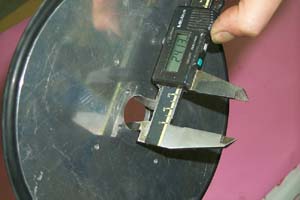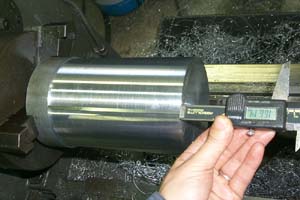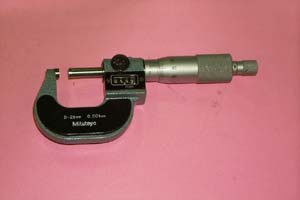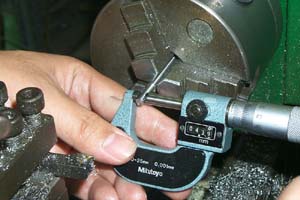|
Chapter 1. Basic Machining and Tips
Measurements
 How to Use Vernier Callipers
How to Use Vernier Callipers
In the machining process, we use vernier callipers or a micrometer for
taking measurements. General analog vernier callipers as shown in Figure
1 can measure with the minimum unit of 1/20 mm. Several types of digital
vernier callipers as shown in Figure 2 can measure with the minimum unit
of 1/100 mm.

Fig. 1, Analog Vernier Callipers
|

Fig. 2, Digital Vernier Callipers
|
 Examples Examples
The vernier callipers can measure a side length, an outer and inner diameter,
and a depth as shown in Figures 3 to 6.

Fig. 3, Measurement of an Outer Diameter
|

Fig. 4, Measurement of a Side Length
|

Fig. 5, Measurement of an Inner Diameter
|

Fig. 6, Measurement of a Depth
|
 Keep a perpendicular position in measuring!
Keep a perpendicular position in measuring!
The vernier callipers must be kept the perpendicular position in measuring.
Typically, when a beginner measures the size of a complex shaped part,
the result can be inaccurate as the measuring device is often not maintained
parallel to measured piece.
|
 How to Use a Micrometer
How to Use a Micrometer
When close tolerances are required, measurements are taken with a micrometer
due to its superior accuracy over a vernier calliper. The micrometer as
shown in Figure 7 can measure with the minimum unit of 1/1000 mm.

Fig. 7, Micrometer
|

Fig. 8, Measurement with a Micrometer
|
 Which do you use the vernier callipers or the micrometer?
Which do you use the vernier callipers or the micrometer?
The "For & Against" of using micrometers and vernier callipers
are:
Vernier Calliper:
For: A large range of measurements can be made using the one measuring device.
Against: The majority of vernier callipers do not provide sufficient accuracy for close tolerance measurements.
Micrometer:
For: The micrometer provides a greater degree of accuracy for close tolerance work.
Against: Due to the limited size range for a given micrometer, it is necessary to have a number of micrometers to cater for the full range of measurements you may encounter.
|
[ Metal Working TOP ]
[ Hirata HOME ]
[ Power and Energy Engineering Division ]
[ NMRI HOME ]
|
 How to Use Vernier Callipers
How to Use Vernier Callipers How to Use a Micrometer
How to Use a Micrometer

 Examples
Examples




